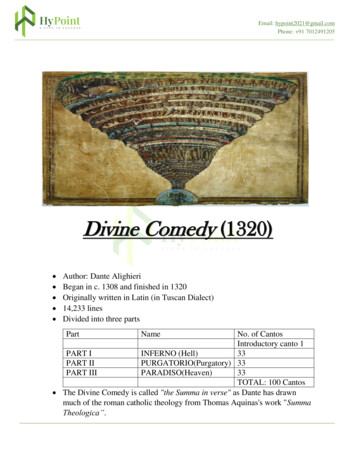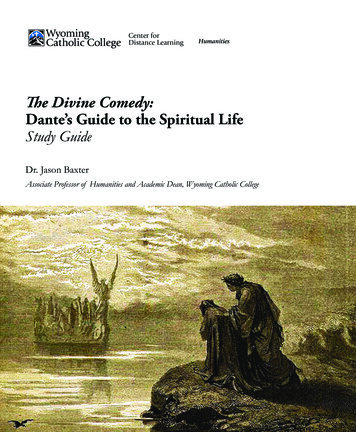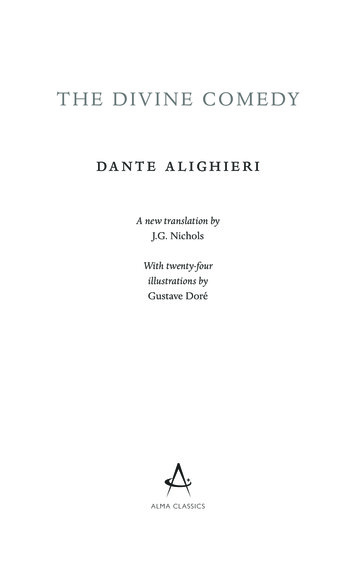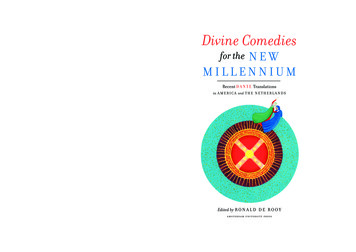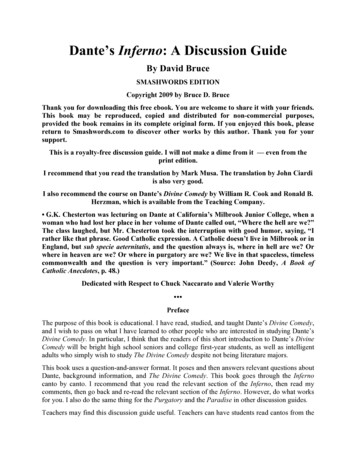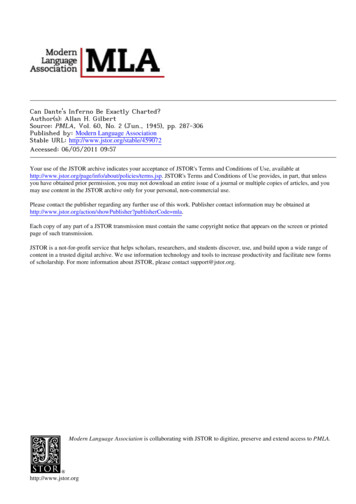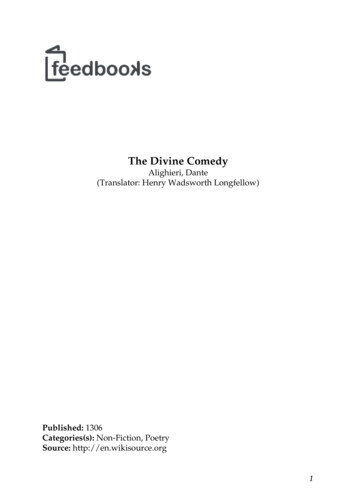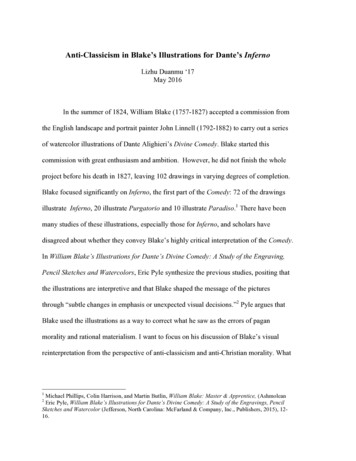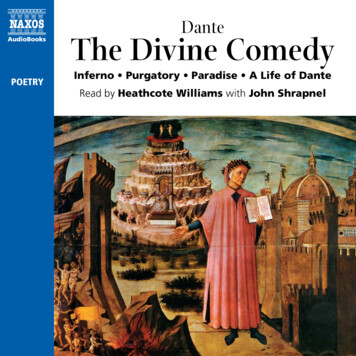
Transcription
DanteThe Divine ComedyPOETRYInferno Purgatory Paradise A Life of DanteRead by Heathcote Williams with John Shrapnel
7:505:587:392
:107:577:556:358:348:30Time: 4:10:303
Purgatory35363738394041424344454647484950Canto ICanto IICanto IIICanto IVCanto VCanto VICanto VIICanto VIIICanto IXCanto XCanto XICanto XIICanto XIIICanto XIVCanto XVCanto 49:078:058:318:114
5152535455565758596061626364656667Canto XVIICanto XVIIICanto XIXCanto XXCanto XXICanto XXIICanto XXIIICanto XXIVCanto XXVCanto XXVICanto XXVIICanto XXVIIICanto XXIXCanto XXXCanto XXXICanto XXXIICanto 7:477:207:557:588:328:59Time: 4:33:285
028:068:027:428:048:436
8:369:05Time: 4:26:457
A Life of Dante101102103104105106107108109110111112113The final journey back to RavennaFlorence – the great city on Arno’s fair riverDante was born in May 1265 The first sight of Beatrice PortinariDeath and philosophyDante marries Gemma DonatiDante, aged 30, 12951300 – political upheaval and the beginning of InfernoDante in exileConvivio – The Banquet – a work of instructionLettersRavenna 1318; death 1321The last 13 cantos of Paradiso; final 15:498:50Time: 79:23Total time: 14:30:06Cover picture: Dante reading from ‘The Divine Comedy’Domenico di Michelino (1417-91) by courtesy Bridgeman Art Library, London8
DanteInferno from The Divine ComedyThe Divine Comedy is an epic poem in threeparts, describing the poet’s imagined journeythrough Hell, Purgatory and Paradise, andculminating in his vision of God.To this extent it has much in common withthe epic masterpieces of Homer and Virgilwhose roots are in history and myth; but theCommedia is also an allegory, dealing withnothing less than man’s relationship with andplace within the universe. Dante’s universe was,of course, a medieval one in which the sunand stars revolved around the Earth, and whilethe Commedia takes account of contemporaryscience in minute detail, his vision of the wayin which the regions of the afterworld might becontained within this framework is brilliant in itsoriginality. Hell (the Inferno) is conceived as atapering funnel plunging down into the earthbeneath the northern hemisphere. At its deepestpoint a passage leads out into the southernhemisphere, where Mount Purgatory – its shapemirroring that of Hell – tapers upwards towardsHeaven. Paradise itself is conceived as a seriesof ten ‘spheres’ encircling the Earth, with Godsomewhere beyond the tenth, merely glimpsedby Dante as consciousness ebbs from him.This colossal construction is subdivided tocreate a zone for every facet of human nature. InHell and Purgatory a place is allotted for every sinand foible which exists within the world, while inParadise the pure and just, the saints and the HolyTrinity are arranged in a strict hierarchy. Dantepeoples each region with figures from literature,history and from his own contemporary society.This allows him to comment on issues of moralitynot in merely abstract terms, but in relationto actual people and events, many of themof titillating contemporary relevance. Becauseof this many of the names encountered meannothing to modern readers, and this is one of thereasons why most editions of Dante incorporatemany pages of notes for each page of text (apractice which began, incidentally, within a fewyears of the poem’s first publication). The mainpurpose, however, is not to point the finger orpoke fun at friends and enemies (though thereis undoubtedly an element of this, especially inthe Inferno), but to examine the reality of man’shuman and spiritual nature in all its various andcomplex manifestations.One of the principal characters in the DivineComedy (though she does not actually appearin the Inferno) is Beatrice, whose significancein Dante’s life needs to be understood. Dantefirst met and fell in love with Beatrice Portinariwhen she was eight and he nine years old. Heworshipped her from afar until her early deathat the age of twenty-four. (The full story of thisstrange ‘love affair’ is told by Dante in his LaVita Nuova.) Beatrice then came to symbolisefor Dante all that is pure and worthy. In theCommedia it is Beatrice who sends the poetVirgil to guide Dante through Hell and Purgatory.There she herself assumes responsibility for his9
journey of discovery, and it is she who revealsto him the splendours of Paradise, leading himeventually to “that love that moves the Sun andother stars”.Dante calls the three books of the DivineComedy ‘canzoni’. Each contains 33 chapters or‘cantos’, except Inferno which has an additionalintroductory canto – making 100 cantos in all.Each canto contains roughly 150 lines composedaccording to a strict metrical and rhyme scheme.The language of the poem is, importantly, notLatin (as was customary for high art in Dante’sday) but the language used by educated peoplein 14th-century Florence. In addition Dante madeliberal use of archaic language and regionaldialects, all of which makes life very difficultfor the modern translator. But Dante’s purposewas to make his work readable by the ‘ordinary’reader – not merely clerics and academics – fordespite its lofty theme and layers of symbolism,the Divine Comedy is intended to speak to usdirectly through the power of Dante’s imageryand narrative skill.This work has not only endured, but hasexerted a powerful influence on Western thoughtfor almost seven centuries, especially perhapsthe Inferno, whose characters and images canbe found peppered throughout literature andart right up to the present day. Tchaikovsky’sFrancesca da Rimini and Puccini’s GianniSchicci are borrowed from it. Illustrations forDante editions inspired well-known masterpiecesby Botticelli, Blake and Doré, while the preRaphaelite painter Dante Gabriel Rossetti – (hisfirst name an obvious choice for a father whowas a Dante scholar and reputedly able torecite the entire Commedia from memory) –10returned time and again to Dante for inspiration,notably in the enigmatic “Beata Beatrix”. SamuelBeckett’s plays and novels are full of allusions toboth Inferno and Purgatory – shades walkingslowly weighed down by leaden cloaks (Inf.Canto XXIII), creatures swimming in mud pokingand whistling at one another (Inf. Canto XXII),and indolent characters with little inclination tostruggle any further (Purg. Canto IV).Listeners to this reading of the Inferno maybe struck, too, by Dante’s extraordinary visionwhen, in Canto XXV, a serpent and sinnercombine and transform one another in a waywhich, it might be supposed, was invented bycomputer ‘morphing’. And no horror film hasyet surpassed the frozen wastes of the deepestregion of Dante’s Hell, where the tears ofthe damned make their eyes freeze over, andwhere the mortal body of a sinner can begin itstorture even before the point of actual death.Be warned.Roger MarshDante Alighieri was born in Florence in 1265into a family of the city’s lesser nobility inreduced circumstances. They were Guelphs, aparty originally identified with the claims of papalauthority and opposed by the Ghibellines, whooffered allegiance to the German Emperors inItaly. By Dante’s time both parties had developedinto vehicles for feud and private interest. In 1302control of Florence fell into the hands of ‘Black’Guelphs and Dante was exiled by the faction. Itwas during this permanent exile from Florencethe Divine Comedy was written, completed theyear of his death in Ravenna, 1321.
“Ah! who could relate how wild this wood was?” (Canto I)11
Canto IDante awakens in a gloomy wood. He tries toleave climbing a sunlit mountain but is drivenback by three beasts (Leopard, Lion and Shewolf, symbolising worldly pleasure, ambition,and avarice). He meets Virgil, the poet, whooffers to guide him.Son of Anchises: This was Aeneas. In theAeneid Virgil retells the story of Aeneas’ flightfrom Troy after its defeat by the Greeks andhis foundation of the city which would becomeRome.A soul worthier than I: Beatrice who, inPurgatory, will take over the role of guide fromVirgil.Canto IILate that evening. Dante doubts his worthinessfor the journey. Virgil comforts him explainingthat he was sent by Beatrice. Dante takes heartand they set out.Silvius’ father: Aeneas, who also journeyed tothe underworld (in the Aeneid) where he met hisfather who prophesied his son’s role in the futureglory of Rome.the dead in suspense: see Canto IVa noble Lady: the Virgin Mary, signifyingcompassion. Interceding on behalf of the PilgrimDante, she begins the process of his rescue byDivine Grace, without which he would be lost.Lucia is Illuminating Grace. Beatrice, whosename means blessedness or salvation appears toreveal the will of God to Virgil and Dante.12Canto IIIThe Poets rrive at the door of Hell and passthrough to the antechamber. Within are shadeswho achieved neither praise nor blame in life,rejected by Heaven and Hell. Charon, who ferriesthe souls of the damned to Hades, refuses toferry the living soul across the Acheron. Dantefalls unconscious.good of intellect: souls who lost sight of the‘Supreme Truth’ or God.great refusal: either Pontius Pilate or CelestineV who abdicated in favour of Boniface VIII.Canto IVDante awakens in the First Circle, or Limbowhose inhabitants were virtuous but livedwithout Christianity. He encounters Homer,Horace, Ovid, Lucan and the great poets, heroesand philosophers of antiquity.A Man of Power: Christ.they are not sinners: The virtuous souls ofLimbo are suspended between the joys ofHeaven and the pains of Hell.The master of men of knowledge: Aristotle.Canto VThey descend to the Second Circle wherethe lustful are carried aloft in a violent wind.Minos, who judges the dead and assigns themtheir place in Hell, bars their way. Dante hearsFrancesca da Rimini’s tale of love and death andfaints with pity.Semiramis: the Assyrian empress, rumouredguilty of incest with her son.
“The winds changed course. They were blown towards us.” (Canto V)13
That other one: Dido, who broke her oath offidelity to her dead husband by falling in lovewith Aeneas.the couple who fly together: Francescadi Rimini and Paolo Malatesta, brother ofFrancesca’s husband Gianciotto, lord of Rimini.Paolo became her lover, until Gianciotto surprisedthem in flagrante delicto and murdered them.Caïna’s depths: one of the four divisions ofCocytus, the lowest (ninth) circle of Hell.Galahad: the name of Lancelot and Guinevere’sgo-between in Lancelot du Lac, the medievalromance.Canto VIDante awakens in the Third Circle where theGluttonous are tormented by freezing filthyrain and the three-headed dog Cerberus, thewatchdog of Hell. Ciacco recognises Dante. Hemakes a prophecy. Virgil describes The FinalJudgement.solid human flesh: shades only appear tohave corporeal form, although they feel actualphysical pain.your city: Florence.Tell me, if you know: a passage referring toevents in Italy, especially Florence, after 1300,the year of Dante’s descent through Hell. Shadesin Hell see the future and the past but knownothing of the present. Ciacco is referring tothe struggle between factions of the Guelphparty. Pope Boniface VIII whose sail trims toany breeze waited for an overall victor beforecommitting his support. Ciacco’s ‘prophecy’ isaccurate, because the events had already takenplace.14Farinata: a Florentine politician. Farinata is inthe circle of Heretics (Canto X); Tegghiaio andJacopo Rusticucci are among the Sodomites(Canto XVI); Mosca is with the Sowers of Discord(Canto XXVIII); Arrigo, does not re-appear.great adversary: in Hell the enemy is Christ.Canto VIIThe poets meet Plutus at the entrance to theFourth Circle. Here the Avaricious and theSpendthrifts roll weights against each other inopposing semi-circles. They descend to the FifthCircle where the Wrathful tear at each other andthe Slothful bubble beneath the Styx.Plutus: god of wealth in myth. The words aregibberish.Michael took his vengeance: against therebellious angels.Charybdis: the whirlpool in the straits ofMessina.These tonsured ones: the avaricious are mostlypriests.Styx: second of the five rivers of Hades. TheAcheron emerges from underground as thespring.Canto VIIIStill in the Fifth Circle Dante and Virgil come toa tall tower. They cross the Styx with Phlegyas,encountering Filippo Argenti. They draw near thered-hot walls of the city of Dis. Their progress tolower Hell is obstructed.Phlegyas: guardian and ferryman of the Styx.Until I was in: Dante, a mortal, has weight.Virgil, a shade, does not.
“The lid of each tomb was pushed to one side,And rising from within came cries of grief ” (Canto IX)15
Filippo Argenti: an enemy of Dante’s. Littleelse is known.the city of Dis: Dis was the Roman name forPluto god of the underworld. Here it is appliedto Lucifer and the city whose walls mark theboundary between upper Hell and lower Hell.Canto IXAt the gate of Dis. Virgil tries to calm Dante’sfear. The Furies appear and Virgil warns Dantenot to look at Medusa. The divine messengerarrives and orders the demons to let the poetsthrough. They enter Dis and reach the Sixth Circlewhere they encounter the Arch-heretics in theirred-hot sepulchres.three Furies: Tisiphone, Megaera and Alecto,bringers of retribution and torment. The Queenof endless misery is Hecate, wife of Pluto.Let Medusa come: one of the three Gorgonsisters whose hair was turned into snakes byMinerva. Theseus, the Athenian hero, descendedto Hell to kidnap Hecate but was kept by Pluto inthe Chair of Forgetfulness. Hercules set him free.Cerberus: when Hercules rescued Theseus hedragged Cerberus up from Hell by a chain,stripping the fur from his throat.Canto XStill in the Sixth Circle the poets come to theHeretics and the Epicureans. Farinata degli Ubertiexplains that souls in Hell know nothing of thepresent but are able to remember the past andforesee the future.Jehosephat: a valley near Jerusalem where theLast Judgement will take place and souls will be16reunited with their bodies.Farinata: di Jacopo degli Uberti, a Ghibelline(pro-imperial) leader in Florence, died 1264. TheGhibellines drove the (pro-papal) Guelph’s fromFlorence on two occasions, but by 1300 theGuelphs had returned to the city.her whose eyes: Beatrice.Canto XIDante and Virgil pause beside Pope Anastasius’tomb before descending to the Seventh Circle.Virgil explains the arrangement of punishmentin Hell. Violence in the three rounds of theSeventh Circle; ordinary fraud in the Eighth Circleand complex fraud in the Ninth. Having passedthrough the circles punishing the (lesser) Mortalsins of Incontinence, Lust, Gluttony, Avarice,Sloth, and Wrath, the sins prompted by Envy andPride lie ahead.Anastasius: Pope 494-498. Held as hereticbecause of his support for Photinus ofThessalonica who denied Christ’s divine birth.Aristotle’s Ethics: a work on politics, the Physicshis work on natural science.Genesis: Man is to work and earn his bread bythe sweat of his brow. Usurers do not, henceusury is sin.Canto XIIThe Seventh Circle, First Round: the ViolentAgainst their Neighbours. The Minotaur and theCentaurs, half man, half horse, led by Chiron.Nessus guides them across the boiling blood ofPhlegethon where the Tyrants and Murderersare immersed.
“We were men once, though we’ve become trees ” (Canto XIII)17
infamy of Crete: the Minotaur, part-man, partbull born of Queen Pasiphaë who satisfied herlust with a bull. He was killed by Theseus dukeof Athens.before he came: Christ, in the harrowing ofHell.Chiron: centaur celebrated for his wisdom,tutor to the Greek heroes.Nessus: centaur killed by Hercules afterattempting to rape his wife Deianara. As Nessusdied he gave her a robe dipped in his bloodwhich, he said, would preserve Hercules’ love.She hanged herself when the robe poisonedHercules.God’s sanctum: In 1272, Guy de Montfortavenged his father, killed by Edward I of England,by murdering Edward’s cousin Prince Henry.Henry’s heart was set up on a column on LondonBridge to be venerated.Pyrrhus: son of Achilles. Sextus, pirate son ofPompey the Great.Rinier da Corneto: highwayman of Dante’stime, as was Rinier Pazzo, who made a habit ofattacking clerics.Canto XIIISeventh Circle, Second Round: the Violent againstThemselves. The Wood of Suicides. Harpies andThe Profligates, hunted by hounds.Cecina and Corneto: the limits of the Maremma,a Tuscan swamp.The tree spoke: Pier delle Vigne, advisor toEmperor Frederick II. Disgraced in 1248 he wasimprisoned and committed suicide. That whoreis envy; Caesar’s household is Frederick’s court;Augustus is the Emperor i.e., Frederick II.18two figures: Profligates who deliberatelydestroyed their wordly goods. Pier delle Vigne,is Arcolano da Squarcia of Padua. Toppo, afamous defeat of the Sienese in 1288, at whichLano wilfully refused to retreat, dying rather thanliving in poverty. Giacomo da Sant’Andrea isreputed to have thrown money into the riverBrenta to while away the time.my home city: Florence, whose first protectorwas Mars, changed to John the Baptist whenthe citizens became Christian. In revenge Marspunishes Florence with constant fighting,allowing it to rebuild itself so long as fragmentsof his statue remain at Arno.Canto XIVSeventh Circle, Third Round: the violent againstGod, Nature and Art. Blasphemers, supine on theburning sand. The Ancient Man of Crete whosetears form the rivers of Hell.Capaneus: one of the Seven who besiegedThebes was struck by Jove’s thunderbolt afterblaspheming that the gods could not defeat him.ancient man: an allegory for the ages of manand the decline of human nature from GoldenAge to Age of Iron. The statue in Crete, thecentre of the known world, is midway betweenthe pagan East (Darmatta, an Egyptian seaport)and the Christian West, Rome. The fissure whichcracks every part except the head is the sorrow inevery Age but the first. The tears are the sourceof the rivers Acheron, Styx and Phlegethon whichcollect at Cocytus, the lowest point of Hell.Lethe: river of forgetfulness.
Canto XVSeventh Circle, Third Round: Sodomites (scholarsand clerics) eternally moving across the burningsand beneath a rain of fire.Brunetto Latini: the Florentine, Guelphstatesman–politician and writer 1212-94 wroteLivres dou Tresor, an encyclopaedic work andTesoretto a didactic poem. He was in some wayan early mentor of Dante.Fiesole: the hill town where Catiline took refugeagainst Caesar. After its destruction the survivors,with a number of Roman families, were used topeople Florence. This mix was seen as the root ofFlorentine civil discord.Priscian: a sixth-century Latin grammarian.Francesco d’Accorso: (1225-94) a celebratedFlorentine jurist.Servant of Servants: Pope Boniface VIII, whotransferred the well-known sodomite Andrea de’Mozzi, bishop of Florence to Vicenza.Canto XVISeventh Circle, Third Round: Sodomites (warriorsand leaders). The decadence of Florence.Phlegethon plummets over the precipice. Dante’scord summons a monstrous figure.Guido Guerra and Tegghiaio Aldobrandi:Guelph leaders. Little is known of JacopoRusticucci. My downfall was my wife suggestshe was driven to homosexuality by her.the centre: to Cocytus, the centre of the earthand the lowest part of Hell.19Canto XVIIGeryon. Seventh Circle Third Round: ViolentAgainst Nature and Art. Usurers with theirpurses. Virgil and Dante descend to the EighthCircle.the monster: Geryon was the mythologicalSpanish giant king killed by Hercules in thecourse of his Labours.Arachne: the weaver whose work rivalledMinerva’s. She was turned into a spider.beaver dips its tail: the beaver was supposed tocatch fish by dangling its tail in the water.The sovereign cavalier: held to be GianniBuiamonte di Becchi, a usurer who held highoffice in Florence.Phaeton: begged Apollo to let him drive theSun-chariot. He was unable to control it andburnt the streak of sky known as the Milky Way.Canto XVIIIThe Eighth Circle, Malebolge, with Ten Ditchescontaining those who committed Fraud againstmankind in general. The First Ditch; Pandersand Seducers, scourged by demons. The SecondDitch; Flatterers immersed in filth.Malebolge: a word invented by Dante meaning‘evil pouches’, where sinners are pocketed in aset of concentric ditches.Jubilee year: 1300, when Boniface VIII grantedabsolution to those who made a pilgrimageto Rome. Many thousands came and a trafficcontrol system was instituted.Venedico Cacciamenico: a Bolognese Guelphwho procured his sister Ghisolabella for theMarchese of Ferrara.
“Look, the monster with its sharpened tail ” (Canto XVII)20
“Out of the mouth of each hole there emergedA sinner’s feet and his legs up to the calf.” (Canto XIX)21
“Grappled him by his sticky, pitchy hair,And hauled him up ” (Canto XXII)22
sipa: the word for ‘yes’ in the Bolognese dialect.Caccianemico suggests there are more Bolognesein the ditch than in Bologna.other misbegotten spirits: seducers, whodefraud the innocent for their gain.Jason: leader of the Argonauts, who capturedthe golden fleece. Sailing home he stoppedat Lemnos where he seduced Hypsipyle, butabandoned her, pregnant. The men of Lemnoswere slaughtered because they had broughthome Thracian concubines. Hypsipyle gulled theother women by hiding her father, Thoas, theking, pretending she had slain him. Later Jasonmarried Medea, the sorceress, but abandonedher too. Medea took her revenge by killingCreusa, for whom Jason had abandoned her andmurdered her own children.Canto XIXThe Eighth Circle, Third Ditch: the Simonistsset head down into holes in the rock, flamestormenting their feet.Simon Magus: tried to buy the power of theHoly Spirit from Peter and John. The sin ofsimony, the fraudulent use of the Church andsale of its offices for money or power, derivesfrom his name.Whoever you may be: Pope Nicholas III.vile assassin: in the Florence of Dante’s timemurderers were executed by being placed upsidedown in a hole which was then filled with earth.Is that you Boniface: the soul, able to seethe future knows Boniface VIII will take his placeon his death, in 1303. Since it is 1300 Nicholasthinks the writings lied; Boniface is early. Bonifacetricked Celestine V into abdicating the See of St23Peter and was infamous for simony.Fairest of Women: the Church.great mantle: the papacy.one of the she-bear’s sons: Nicholas III was adegli Orsini, which means of the little bears (orsa bear), notorious for simony and nepotism – hisdesire to advance the bear-cubs.lawless shepherd: another corrupt pope,Clement V, puppet of Philip, King of France.Canto XXEighth Circle, Fourth Ditch: Soothsayers,Astrologers, Magicians, whose heads are twistedso that they look only backwards. Virgil explainsthe origin of Mantua.amazing deformation: these sinners whoattempted to divine the future, are forced tolook backwards eternally.Amphiareus: another of the seven kings whoassaulted Thebes and a seer.Tiresius: a soothsayer of Thebes.Michael Scott: a Scottish philosopher (11751235). Reputedly a magician.Cain with his thorns: the medieval Italianequivalent of ‘the man in the moon’.Canto XXIEighth Circle, Fifth Ditch: Barrators, swindlers incivic and public office, plunged beneath boilingpitch guarded by demons. A new arrival fromLucca. Dante and Virgil proceed, escorted bydemons.Malebranche: the generic name for the demons.Sacred Face: a crucifix at the cathedral in Lucca.The Serchio is a nearby river – perhaps the
sinner is lying on his back in the pitch with hisarms open.smashed to bits: broken by the earthquake atthe death of Christ.Canto XXIIEighth Circle, Fifth Ditch Barrators. The demonsfork out a Navarrese barrator from the pitch.The Navarrese plays a trick; two demons end upin the pitch.You Aretines: Dante was at the battle ofCampaldino 1289, when Guelphs from Florenceand Lucca defeated Ghibellines from Arezzo.Gomita: a Sardinian friar hanged when it wasdiscovered he was selling prisoners freedom.Don Michele Zanche: governor of anotherSardinian district, Logodoro. Murdered in 1275by his son-in-law Branca d’Oria.Canto XXIIIEighth Circle, Fifth Ditch: Barrators. Pursued bydemons, Dante and Virgil escape by scramblingdown the bank into the Sixth Ditch where theHypocrites file along beneath cloaks of lead. TheJovial Friars of Bologna.King Frederick’s: a punishment instituted byEmperor Frederick II for traitors. They were givena leaden cape, which was melted on their bodies.Jovial Friars: the nickname of a religious Orderof Knights dedicated to the Virgin; disbandedbecause of scandalous corruption.nailed down figure: Caiaphas, High Priest ofthe Pharisees urged the death of Jesus. Annas,Caiaphas’ father-in-law, is one of the counsellorswho seeded so much evil; the destruction of24Jerusalem and the dispersal of the Jews.Canto XXIVA difficult passage to the Eighth Circle, SeventhDitch. The Thieves. The sinner bitten by a serpentturns to ash, then resumes his shape. VanniFucci, and his prophecy.heliotrope: a stone that protected the wearerfrom snake bite.Vanni Fucci: violent bastard of Fuccio de’Lazarri, a leader of the Black Guelph faction inPistoia. He is here because of his theft of treasurefrom the chapel of Saint James in Pistoia. Vanni’s‘prophecy’ meant the Florentine White Guelphswould help the White Pisoians score a victoryover the Blacks in May 1301. That autumnCharles of Valois arrived in Florence, sided withthe Blacks and turfed out the Whites. MoroeloMalaspina, lord of Lunigniana (Valdimagra), isthe fiery thunderbolt, who drove the Whitesfrom their last stronghold in Tuscany.Canto XXVEighth Circle, Seventh Ditch: the Thieves. Thecentaur Cacus. Three Florentine thieves arrive,then two more in the form of snakes. Bizarremetamorphoses occur.Pistoia: was supposedly founded by theremnants of the army of Catiline, composed ofcriminals and brigands.fell from Thebes rampart: Capaneus.Cacus: the son of Vulcan and Medusa. Dantemakes him a centaur.deceitful robbery: Cacus stole the oxen ofGeryon belonging to Hercules.
from where unborn we feed: the navel.Lucan be silent here: in the Pharsalia Lucantells of two soldiers bitten by snakes; Sabelluswas reduced to a puddle of liquid, the otherNassidius swelled up until he died. Oviddescribes Cadmus turning into a snake andArethusa into a fountain.Puccio Sciancato: ‘Sciancato’, the nickname ofPuccio dei Galigai, a Florentine thief.Gaville: a village in the Arno valley. Francescodei Cavalcanti was killed by the inhabitants. Hisfamily avenged his death.Canto XXVIThey leave the Seventh Ditch for the EighthDitch, Dante, condemns Florence. The poets viewthe Eighth Ditch, where those who counselledfraud burn in the flames that enclose them.Ulysses and Diomedes share a flame. Ulyssesdescribes his final voyage.avenged by bears: Elisha, mocked by someboys who were later eaten by bears. He sawElijah ascend to heaven in a fiery chariot.Eteocles and his brother: Polynices, sons ofOedipus, so hated each other the flames on theirjoint funeral pyre refused to mingle.Ulysses: (Odysseus) the Greek hero whofought at Troy with Diomedes and devised thestratagem of the Wooden Horse. Deïdamia wasthe daughter of king of Scyros and mother ofAchilles’ child. The Palladium was the sacredsymbol of Troy and guarantee of its safety: itstheft meant the city would fall.Leaving Circe: journeying home from Troy,Ulysses was detained by the sorceress Circe.Gaëta: a promontory near Naples Aeneas named25after his nurse, Caita.narrow strait: Gibraltar, where the pillars ofHercules marked the westernmost end of theknown world.a mountain: the Mount of Purgatory.Canto XXVIIEighth Circle, Eighth Ditch: FraudulentCounsellors. The state of Romagna. Guido’s taleof self-deception.As the torturer’s Sicilian bull: Perillus ofSicily constructed a brass bull as an instrumentof torture for the tyrant Phalaris. Victims wereroasted inside the bull so fashioned that theircries sounded as if the bull itself was bellowing.Perillus was its first victim.Those hills between Urbino: a regioncalled Montafeltro. The speaker is Guido daMontefeltro.If I believed: Guido was known as one of thewiliest soldiers and politicians of his time. Hefought successfully for the Ghibellines againstPapal and Guelph forces in Romagna between1274 and 1282. Excommunicated and banishedhe returned to Pisa to lead its Ghibellines, butwas reconciled with the church by 1296 andbecame a Franciscan friar.Prince of Pharisees: Boniface VIII, who ratherthan crusading against the traditional enemies ofthe church, Saracens or Jews, chose to subduethe Colonna family, who refused to recognisehis papacy.“He asked me for my counsel ”: TheColonna family took refuge in their fortress ofPalestrina, near the Lateran, the papal palacein Rome. Advised by Guido da Montefeltro,
Boniface falsely promised them a pardon. Theysurrendered and lost everything.The two keys: symbols of papal authority.Canto XXVIIIEighth Circle, Ninth Ditch: the sowers of discordperpetually circling wounded after each turnby a demon. Mohammed and Ali. Warnings tothose still alive.Apulia’s fateful earth: to Dante ‘Apulia’described southern Italy, sc
The Divine Comedy is an epic poem in three parts, describing the poet's imagined journey through Hell, Purgatory and Paradise, and culminating in his vision of God. To this extent it has much in common with the epic masterpieces of Homer and Virgil whose roots are in history and myth; but the Commedia is also an allegory, dealing with

